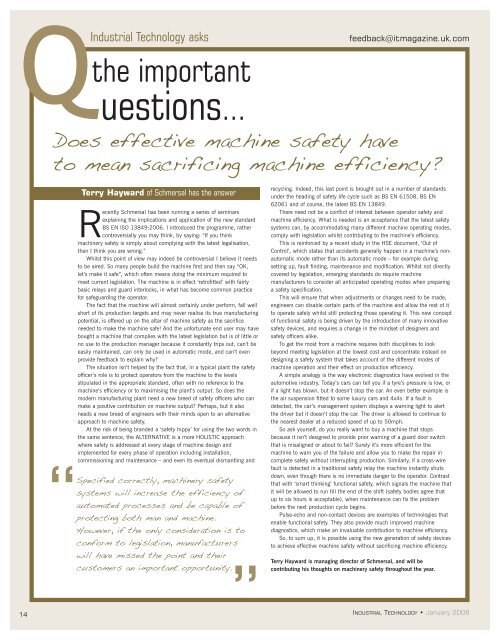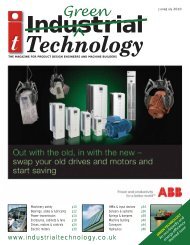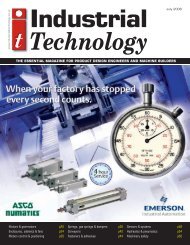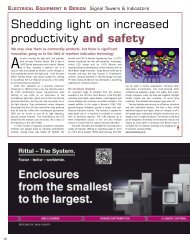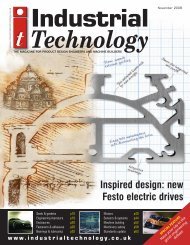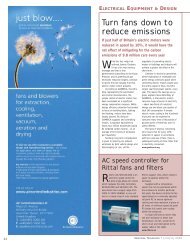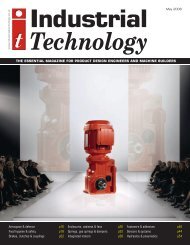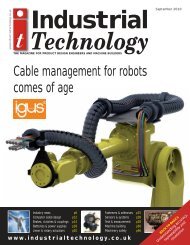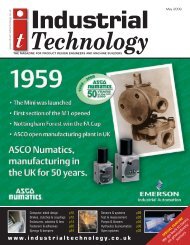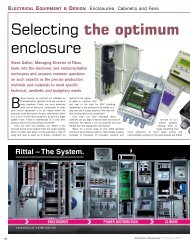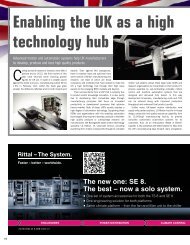IT Jan 2008 - Industrial Technology Magazine
IT Jan 2008 - Industrial Technology Magazine
IT Jan 2008 - Industrial Technology Magazine
You also want an ePaper? Increase the reach of your titles
YUMPU automatically turns print PDFs into web optimized ePapers that Google loves.
Q<strong>Industrial</strong> <strong>Technology</strong> asks<br />
the important<br />
uestions...<br />
feedback@itmagazine.uk.com<br />
Does effective machine safety have<br />
to mean sacrificing machine efficiency?<br />
recycling. Indeed, this last point is brought out in a number of standards<br />
Terry Hayward of Schmersal has the answer<br />
under the heading of safety life cycle such as BS EN 61508, BS EN<br />
62061 and of course, the latest BS EN 13849.<br />
Recently Schmersal has been running a series of seminars<br />
There need not be a conflict of interest between operator safety and<br />
explaining the implications and application of the new standard machine efficiency. What is needed is an acceptance that the latest safety<br />
BS EN ISO 13849:2006. I introduced the programme, rather systems can, by accommodating many different machine operating modes,<br />
controversially you may think, by saying: “If you think<br />
comply with legislation whilst contributing to the machine’s efficiency.<br />
machinery safety is simply about complying with the latest legalisation,<br />
This is reinforced by a recent study in the HSE document, ‘Out of<br />
then I think you are wrong.”<br />
Control’, which states that accidents generally happen in a machine’s nonautomatic<br />
Whilst this point of view may indeed be controversial I believe it needs<br />
mode rather than its automatic mode – for example during<br />
to be aired. So many people build the machine first and then say “OK, setting up, fault finding, maintenance and modification. Whilst not directly<br />
let’s make it safe”, which often means doing the minimum required to covered by legislation, emerging standards do require machine<br />
meet current legislation. The machine is in effect ‘retrofitted’ with fairly manufacturers to consider all anticipated operating modes when preparing<br />
basic relays and guard interlocks, in what has become common practice a safety specification.<br />
for safeguarding the operator.<br />
This will ensure that when adjustments or changes need to be made,<br />
The fact that the machine will almost certainly under perform, fall well engineers can disable certain parts of the machine and allow the rest of it<br />
short of its production targets and may never realise its true manufacturing to operate safely whilst still protecting those operating it. This new concept<br />
potential, is offered up on the altar of machine safety as the sacrifice of functional safety is being driven by the introduction of many innovative<br />
needed to make the machine safe! And the unfortunate end user may have safety devices, and requires a change in the mindset of designers and<br />
bought a machine that complies with the latest legislation but is of little or safety officers alike.<br />
no use to the production manager because it constantly trips out, can’t be To get the most from a machine requires both disciplines to look<br />
easily maintained, can only be used in automatic mode, and can’t even beyond meeting legislation at the lowest cost and concentrate instead on<br />
provide feedback to explain why?<br />
designing a safety system that takes account of the different modes of<br />
The situation isn’t helped by the fact that, in a typical plant the safety machine operation and their effect on production efficiency.<br />
officer’s role is to protect operators from the machine to the levels<br />
A simple analogy is the way electronic diagnostics have evolved in the<br />
stipulated in the appropriate standard, often with no reference to the automotive industry. Today’s cars can tell you if a tyre’s pressure is low, or<br />
machine’s efficiency or to maximising the plant’s output. So does the if a light has blown, but it doesn’t stop the car. An even better example is<br />
modern manufacturing plant need a new breed of safety officers who can the air suspension fitted to some luxury cars and 4x4s. If a fault is<br />
make a positive contribution on machine output? Perhaps, but it also detected, the car’s management system displays a warning light to alert<br />
needs a new breed of engineers with their minds open to an alternative the driver but it doesn’t stop the car. The driver is allowed to continue to<br />
approach to machine safety.<br />
the nearest dealer at a reduced speed of up to 50mph.<br />
At the risk of being branded a ‘safety hippy’ for using the two words in So ask yourself, do you really want to buy a machine that stops<br />
the same sentence, the ALTERNATIVE is a more HOLISTIC approach because it isn’t designed to provide prior warning of a guard door switch<br />
where safety is addressed at every stage of machine design and<br />
that is misaligned or about to fail? Surely it’s more efficient for the<br />
implemented for every phase of operation including installation,<br />
machine to warn you of the failure and allow you to make the repair in<br />
commissioning and maintenance – and even its eventual dismantling and complete safety without interrupting production. Similarly, if a cross-wire<br />
“<br />
fault is detected in a traditional safety relay the machine instantly shuts<br />
down, even though there is no immediate danger to the operator. Contrast<br />
Specified correctly, machinery safety<br />
that with ‘smart thinking’ functional safety, which signals the machine that<br />
systems will increase the efficiency of it will be allowed to run till the end of the shift (safety bodies agree that<br />
up to six hours is acceptable), when maintenance can fix the problem<br />
automated processes and be capable of before the next production cycle begins.<br />
Pulse-echo and non-contact devices are examples of technologies that<br />
protecting both man and machine.<br />
enable functional safety. They also provide much improved machine<br />
However, if the only consideration is to diagnostics, which make an invaluable contribution to machine efficiency.<br />
So, to sum up, it is possible using the new generation of safety devices<br />
conform to legislation, manufacturers<br />
to achieve effective machine safety without sacrificing machine efficiency.<br />
will have missed the point and their<br />
”<br />
Terry Hayward is managing director of Schmersal, and will be<br />
customers an important opportunity.<br />
contributing his thoughts on machinery safety throughout the year.<br />
14<br />
INDUSTRIAL TECHNOLOGY • <strong>Jan</strong>uary <strong>2008</strong>


